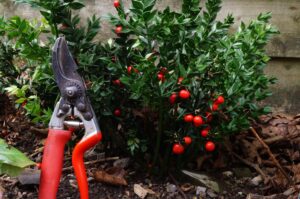Ruscus aculeatus ‘John Redmond’
Ruscus aculeatus is notable as having cladodes rather than leaves. The cladodes are a
spine tipped, flattened section of stem and it is on these cladodes that the flowers
appear. Although minute, the resulting fruit of the fertilised female flowers reveals their
presence. Having escaped from gardens, it occurs in various places across the island
but has been present for more than two centuries in the Muckross area of Killarney, Co
Kerry. It is more often used in gardens for its ability to survive in areas with low light
levels or as a plant to deter man or animal.
The species grows to a little more than a half metre tall but the cultivar of Irish origin is a
more compact plant moving it from the category of “deterrent” to “sharp but worth it”.
As a hermaphrodite form of the species, Ruscus aculeatus ‘John Redmond’ reliably
produces berries which are long lasting and bright red.
In Newsletter No 111, January 2009, the late Ed Bowden corrected the entry for the
cultivar’s origin in A Heritage of Beauty by telling the story of how John Redmond came
across the cultivar in St. Joseph’s Church, Berkley Road in Dublin, its propagation and
the application for Plant Breeders’ Rights by Laddie de Jong of Marian Nurseries and
wrote that the original plant could still be seen in the grounds of the church. I checked
recently and it is still there. The Royal Horticultural Society was so impressed by its
performance that they awarded it an AGM.
(As appeared in Newsletter 154, January 2022. Text and photo courtesy of Brendan Sayers)

